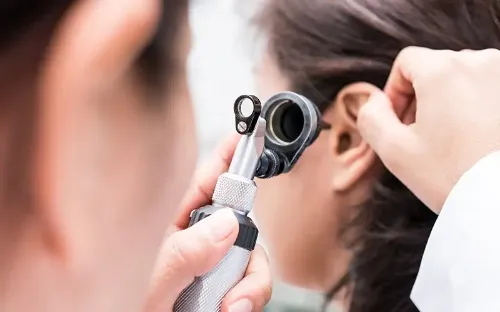Otitis
"A complete head and neck scan is necessary to identify factors that predispose to this type of problem".
DR. FRANCISCO JAVIER CERVERA
SPECIALIST. OTORHINOLARYNGOLOGY DEPARTMENT

What is otitis?
Otitis, like any other dynamic process, can be classified according to the time sequence of the disease in acute (duration of symptoms between 0 and 3 weeks), subacute (3 to 12 weeks) and chronic (more than 12 weeks).
Likewise, depending on the evolution of otitis media, it can present a fluid effusion (seromucosal otitis media) in the middle ear that can be serous (fluid, water-like), mucosal (viscous, mucus-like) or purulent (pus).

What are the symptoms of otitis?
In the acute form of the disease there is ear pain (otalgia), fever, tinnitus and irritability.
Less frequently it can present otorrhea (suppuration), vertigo and more rarely facial paralysis.
In chronic otitis media with effusion, hearing loss may be the only symptom.
Most common symptoms:
- Earache.
- Fever.
- Otorrea.
- Vertigo.
Do you have any of these symptoms?
You may have an otitis
What are the causes of otitis?
The most frequently detected germs in otitis are Streptococcus pneumoniae, Haemophylus influenzae and less frequently Bramanella catarralis, Group A Streptococcus and Staphylococcus aureus.
In addition to bacteria, viruses also play a very important role in the pathogenesis of otitis, the most frequently involved being respiratory syncytial virus, influenzae virus, parainfluenzae virus, adenovirus, rhinovirus and enterovirus.
What is the prognosis of otitis?
With the appropriate treatment, most of the sequelae that these episodes can produce in the different structures of the middle ear are avoided and the patient is prevented from suffering from chronic otitis media with functional ear disorder to a greater or lesser degree in adult life.
The insertion of drainage tubes does not imply a treatment aimed at correcting the cause of the otitis but keeps the middle ear in favourable conditions to avoid subsequent sequelae and allow good hearing.
During the time that the drainage tubes are in place, water must be prevented from entering the ears due to the risk of infection that this entails.
How is otitis diagnosed?

For the diagnosis of otitis, a medical history and otoscopic examination are usually sufficient.
The otoscopic examination is the most important examination for the diagnosis. Likewise, the performance of a pneumatic otoscopy can be essential to precise and determine the mobility of the tympanic membrane.
Another common examination performed is tympanometry, which sometimes helps to confirm the findings in otoscopy or pneumatic otoscopy. This test makes it possible to objectify the state of the tympanic membrane and the mobility of the ossicular chain.
The audiometric test (audiometry) can be useful to confirm and establish the level of hearing loss that is mainly caused by chronic otitis media with effusion.
How is otitis treated?
The usual treatment of otitis is done with antibiotics for 10 or 14 days. Usually, with the antibiotic treatment the symptomatology improves significantly in 48 hours. However, if there is effusion in the middle ear it can persist for several weeks.
Sometimes nasal decongestants and mucolytics are associated to the antibiotic treatment.
In many cases, especially in children, in which repeated episodes of otitis media occur along with symptoms of adenoiditis and adenoidal hypertrophy, the removal of hypertrophic adenoid tissue and the placement of transtimpanic drainage tubes must be performed, after myringotomy and aspiration of the liquid or effusion located in the middle ear.
Where do we treat it?
IN NAVARRA AND MADRID
The Department of Otolaryngology
of the Clínica Universidad de Navarra
The Department of Otorhinolaryngology of the University of Navarra Clinic is a national and world reference in numerous highly specialized surgical procedures.
We have the latest technology and we perform all diagnostic tests in less than 48 hours in order to offer our patients the best solution in the shortest time possible.
We were one of the first centers in Spain to use robotic surgery in the surgical treatment with the Da Vinci® System.
Organized in specialized units:
- Otology - Hearing.
- Rhinology - Nose.
- Pharyngology - Throat.
- Laryngology - Voice.
- Balance disorders.
- Head and neck problems.

Why at the Clinica?
- Experts in the treatment of hearing problems.
- Pioneers in axillary surgery to avoid scarring.
- National reference center in tissue sealing for tonsil removal.













